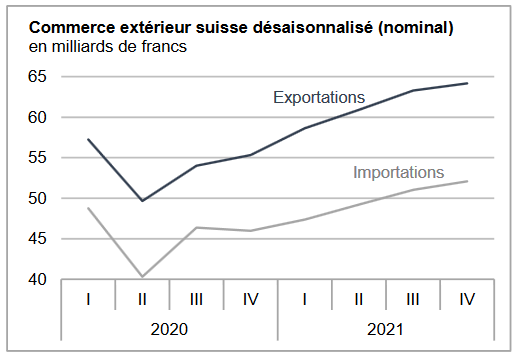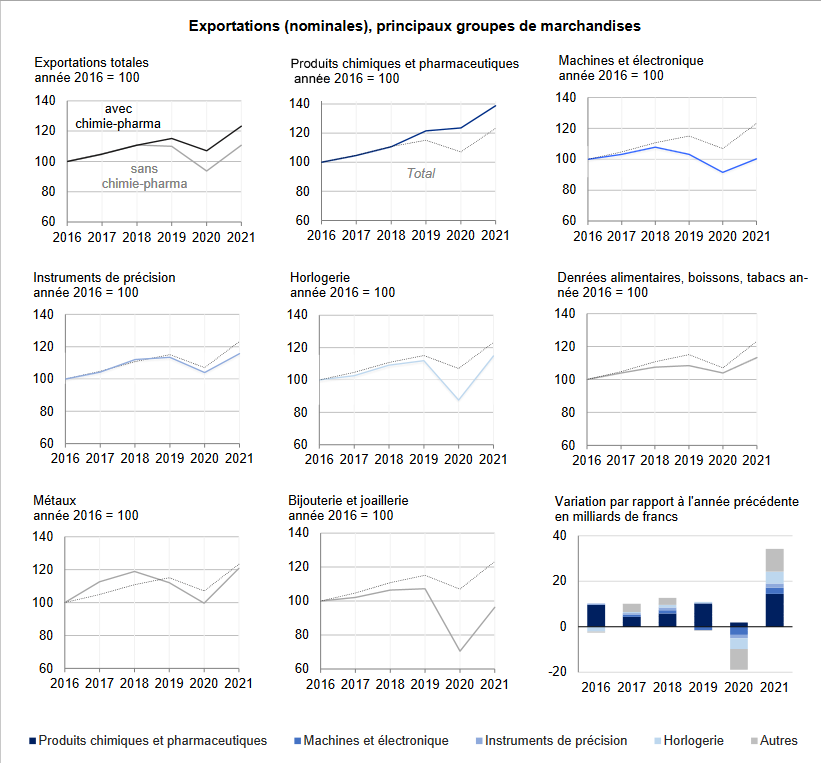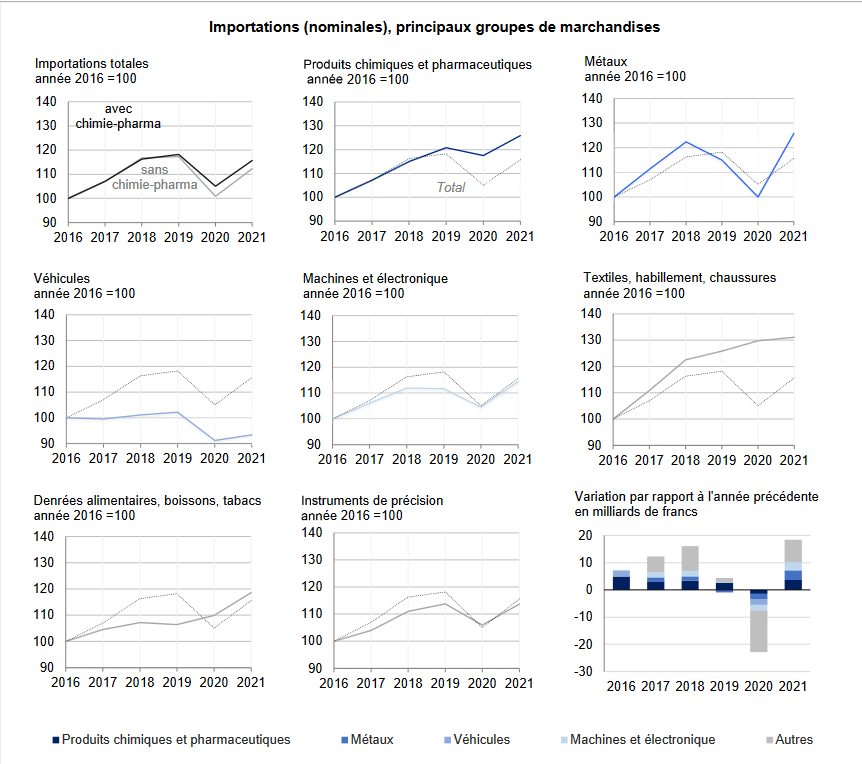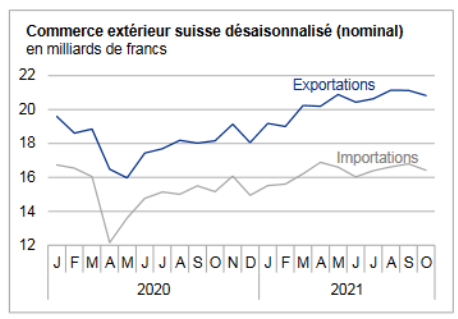We do not like Purchasing Power or Real Effective Exchange Rate (REER) as measurement for currencies. For us, the trade balance decides if a currency is overvalued. Only the trade balance can express productivity gains, while the REER assumes constant productivity in comparison to trade partners. Who has read Michael Pettis, knows that a rising trade surplus may also be caused by a higher savings rate while the trade partners decided to spend more. This is partially true. Recently Europeans started to increase their savings rate, while Americans reduced it. This has led to a rising trade and current surplus for the Europeans. But also to a massive Swiss trade surplus with the United States, that lifted Switzerland on the U.S. currency manipulation watch list. To
Topics:
George Dorgan considers the following as important: 2.) Trade Balance News Service Bunt [FR], 2) Swiss and European Macro, Featured, newsletter
This could be interesting, too:
Nachrichten Ticker - www.finanzen.ch writes Die Performance der Kryptowährungen in KW 9: Das hat sich bei Bitcoin, Ether & Co. getan
Nachrichten Ticker - www.finanzen.ch writes Wer verbirgt sich hinter der Ethereum-Technologie?
Martin Hartmann writes Eine Analyse nach den Lehren von Milton Friedman
Marc Chandler writes March 2025 Monthly
We do not like Purchasing Power or Real Effective Exchange Rate (REER) as measurement for currencies. For us, the trade balance decides if a currency is overvalued. Only the trade balance can express productivity gains, while the REER assumes constant productivity in comparison to trade partners.
Who has read Michael Pettis, knows that a rising trade surplus may also be caused by a higher savings rate while the trade partners decided to spend more. This is partially true. Recently Europeans started to increase their savings rate, while Americans reduced it. This has led to a rising trade and current surplus for the Europeans. But also to a massive Swiss trade surplus with the United States, that lifted Switzerland on the U.S. currency manipulation watch list.
To control the trade balance against this “savings effect”, economists may look at imports. When imports are rising at the same pace as GDP or consumption, then there is no such “savings effect”.
After the record trade surpluses, the Swiss economy may have turned around: consumption and imports are finally rising more than in 2015 and early 2016. In March the trade surplus got bigger again, still shy of the records in 2016.
Swiss National Bank wants to keep non-profitable sectors alive
Swiss exports are moving more and more toward higher value sectors: away from watches, jewelry and manufacturing towards chemicals and pharmaceuticals. With currency interventions, the SNB is trying to keep sectors alive, that would not survive without interventions.
At the same time, importers keep the currency gains of imported goods and return little to the consumer. This tendency is accentuated by the SNB, that makes the franc weaker.
Texts and Charts from the Swiss customs data release (translated from French).
| After a year 2020 strongly affected by the Covid-19 pandemic, Swiss foreign trade proved to be very dynamic in 2021. Exports thus jumped by 15.2% – reaching a record level – while imports swelled by 10 .1%. The different pace of growth at entry and exit explained the jump in the trade surplus to the imposing level of 58.7 billion francs.
In short ⇑ Exports: the USA becomes the first Swiss market ⇑ Foreign trade with China reaches a record level ⇑ Watchmaking: a third increase in exports and a new all-time high ⇓Jewellery imports: 8.8 billion francs below their level pre-Covid-19 |
Swiss exports and imports, seasonally adjusted (in bn CHF), Year 2021 |
Global developmentExports grew by 15.2% over one year (actual: +9.5%) to reach a record level of 259.5 billion francs. On a seasonally adjusted basis, the 1st quarter of 2021 posted an increase of 6.0%, this dynamism continuing during the following two before fading in the last (+1.4%). Imports increased by 10.1% to 200.8 billion francs (actual: +1.1%), i.e. a level 4.4 billion francs lower than before Covid-19. The trade balance surplus has risen again, from 43.0 (2020) to 58.7 billion francs in 2021. |
Switzerland Trade Balance, December 2021(see more posts on Switzerland Trade Balance, )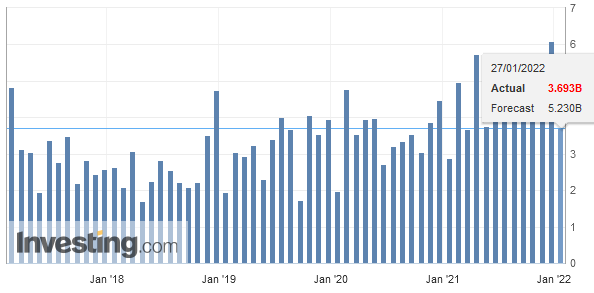 Source: investing.com - Click to enlarge |
Exports: immunological products generate a quarter of the increaseAfter the historic decline of the previous year – induced by the Covid-19 pandemic crisis – all sectors posted an increase in 2021. With +14.4 billion francs, chemical and pharmaceutical products (+12.4 %) contributed the most to growth. Here, exports of immunological products increased by a quarter (+8.8 billion francs). The watch industry also rode the wave of success: its turnover rose by a third, or 5.3 billion francs, to reach a record annual level. While jewelry and jewelery (+2.8 billion) showed similar growth, its sales stood at an even lower level of 1.2 billion francs than before Covid-19. After declining in the two previous years, the machinery and electronics and metals sectors increased by one tenth (+2.7 billion) and one fifth (+2.6 billion) respectively. Sales of precision instruments rose by 11.2% or 1.8 billion francs. On the three main markets, Swiss exports gained ground. Shipments to Europe (+18.1% or +21.9 billion francs) and North America (+17.0% or +7.4 billion) posted double-digit growth. Exports to Asia grew by 9.0% (+4.4 billion), boosted in particular by Hong Kong (+23.0%), China (new record), Japan and Singapore. On the Old Continent, Spain (+5.1 billion) stood out. The cumulative increase in Germany, France and Italy reached 9.2 billion francs. Growing by 18.8% (+7.4 billion), deliveries to the USA for their part reached a record level. At the same time, they dethroned Germany from the status of main outlet, a rank that its German neighbor had held since 1954. |
Swiss Exports per Sector December 2021 vs. 2020 |
Imports: the rise in prices boosted the result of energy productsAlso at the entrance, the lights were green for all groups of goods. Chemicals and pharmaceuticals (+7.1%) contributed 3.6 billion francs to growth, mainly in favor of immunological products. Arrivals of metals increased by a quarter (or 3.3 billion francs). Those of energy products jumped by 3.9 billion francs or 69%, this increase being explained solely by the price effect (actual: -1.6%). The foodstuffs, beverages and tobacco sector was not left out: up 7.9% year-on-year, its imports reached a historic high. After their setbacks of the previous year, the jewelery and jewelery sectors as well as vehicles improved by 2.8 and 2.4% respectively. However, these evolved significantly below their pre-Covid-19 level, proving to be respectively 8.8 (gold jewelry for redesign above all) and 1.7 billion francs below their 2019 level. In 2021, imports from the three main supply markets increased again. The prize went to Europe, up 10.9% or 13.9 billion francs. Here, Spain and France stood out with an increase of one-fifth each. The largest contribution, however, can be attributed to Germany (+5.5 billion francs; +11.2%). Imports from Asia gained 8.0% (+3.1 billion). Here, China alone increased by 1.8 billion francs to reach a historic level. Deliveries from South Korea jumped by 1.1 billion francs and thus more than doubled over one year. North America, for its part, grew by 6.6% or 803 million francs (USA: +643 million francs). |
Swiss Imports per Sector December 2021 vs. 2020 |
Tags: Featured,newsletter

